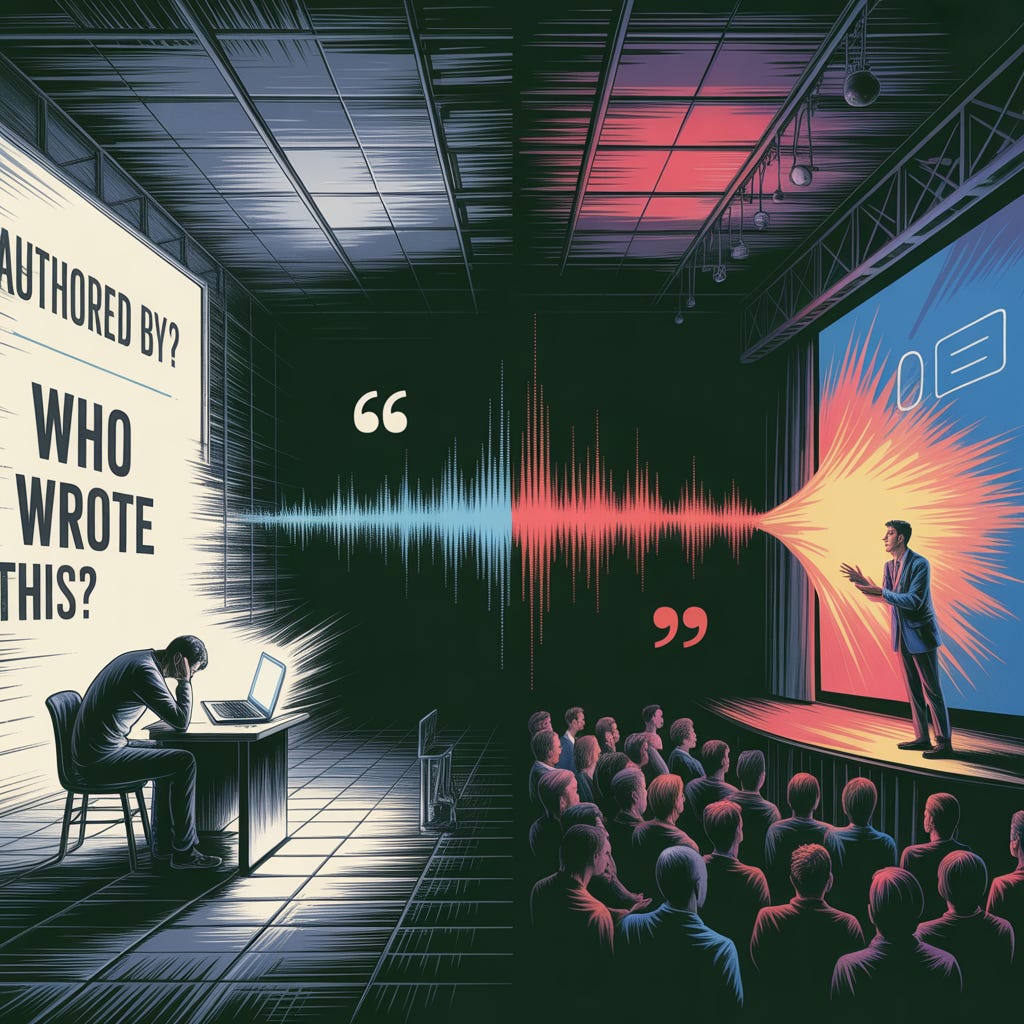Rewriting Expression: AI and the Shift to Spoken Communication
Equip Students to Speak Powerfully, and Write Meaningfully.
For centuries, writing has been the dominant medium for demonstrating thought, learning, and self-expression. From academic essays to professional reports, writing has served as the currency of competence and authenticity. But that era is ending.
We are now entering a new age — one in which in-person oral communication will reassert itself as the cornerstone of trust, assessment, and collaboration.
Below, I outline why this change is happening, what it means for education and society, and why cultivating speech-based skills will be more essential than ever.
PART I: Why Writing is Losing Its Status
1. Writing is No Longer Viewed as Authentically Human
For centuries, writing has been a trusted window into a person’s mind — a way to share ideas shaped by effort, intention, and personal insight. When you read a college essay, an op-ed, or a research summary, it once felt safe to assume: this is their voice.
But that assumption is becoming harder to make.
As AI tools become increasingly sophisticated, it’s now possible for anyone to produce text that appears polished and articulate with minimal human input. While this opens exciting possibilities, it also creates uncertainty. When everything sounds fluent and professional, how do we know what was truly authored — and by whom?
The line between human and machine-written work is beginning to blur. A document signed by "John Smith" may have been ghostwritten by GPT-5 or Grammarly Go.
Over time, we may start to view writing less as a uniquely human act, and more as a polished product — like stock photography — ubiquitous and easy to generate, but harder to trust.
As AI-generated content becomes the norm, we risk losing something essential: the sense of authorship, the story behind the words, the connection between writer and reader. Without that, the authority and meaning of writing may begin to erode. And with it, the clarity we’ve long relied on to understand not just what was said — but who said it, and why it matters.
If we can’t answer those questions, writing loses its authority.
2. Writing Can No Longer Demonstrate Knowledge or Skill
Once upon a time, producing a five-page argumentative essay or analytical report was proof of knowledge. Now, it’s not.
AI tools can produce that output in seconds — often better than the average student or professional. This means that assigning a paper no longer measures learning. It measures access to tools and perhaps a vague sense of prompt engineering skill.
Even when students write "on their own," we cannot be sure they understood the concepts they wrote about. They might have pasted in bullet points, asked ChatGPT to elaborate, and lightly reworded. The line between expressing knowledge and outsourcing knowledge has become indistinguishable.
3. The Assessment System Was Already Broken — AI Just Exposed It
Let’s be honest: written assessment has been gamed for years. College admissions essays — perhaps the most sacred genre of personal writing — have long been shaped by expensive counselors and essay coaches. Many elite students do not merely get feedback. They outsource story selection, structure, tone, and even “voice” to adults who know what admissions officers want.
AI didn’t break the system. It just made it obvious.
Now every student, not just those with $10,000 consultants, has access to linguistic superpowers. The result? A crisis of confidence in written work, not just in school but across journalism, corporate writing, and public discourse.
PART II: The Rise of the Oral
So what replaces writing?
The answer: speaking. Human voice. Oral expression. Dialogue.
Not because it’s trendy — but because it’s hard to fake.
1. Speaking as a Tool of Assessment
Want to know if someone understands their topic? Ask them a question.
In debate rounds, students who rely too heavily on help of others to prepare their debate materials are quickly exposed in crossfire and later speeches where they must defend their arguments against new (to them) ideas that are introduced in the debate.. They freeze. They repeat phrases. They fumble when asked to explain why their evidence matters.
This is why oral exams, interviews, and presentations will rise in status. They aren’t just more “interactive.” They’re more authentic. They reveal whether a person actually knows what they’re talking about — or whether they borrowed someone else’s words.
Speaking is performative, embodied, dynamic. You can’t outsource it in real-time. This is why orality will become the new proof of knowledge.
2. Orality in the Age of Human-AI Collaboration
In a world where AI can do most of the work, human value will reside in how we communicate, explain, and negotiate meaning.
Oral skills will become central to:
Collaborative problem-solving
Teaching and facilitation
Persuasive leadership
Strategic dialogue between humans and AIs
In short: speaking is how humans remain human — how we co-create meaning in an age of machine-generated content. It’s not just about what we say, but how we engage, question, clarify, and connect.
3. College Admissions Are Already Evolving
Some forward-thinking institutions are catching on.
Consider the emerging shift from traditional personal statements to what Perplexity has called "dialogue portfolios" — interactive assessments where students talk about their work, reflect on their learning, and demonstrate who they are beyond what AI can generate.
This isn’t science fiction. It’s already happening.
Portfolios, interviews, and oral defenses are becoming a more reliable signal of authenticity than essays ever were. Because when you speak, you leave a trace of yourself — your hesitations, your tone, your conviction. That’s very hard to fake.
[Link]
PART III: What Schools Must Do — A Call to Action
1. K–12 Must Catch Up
If the most prestigious colleges are moving toward oral and dialogic assessment, then K–12 education must prepare students for that future.
This means integrating:
Oral presentations into academic classes
Reflective dialogue into project-based learning
Collaborative discussion into STEM and humanities
Frequent, high-quality speaking opportunities across disciplines
But above all, it means investing in speech and debate programs that provide systematic, intensive, and iterative practice.
2. Speech & Debate: The Ultimate Training Ground
No other school activity prepares students for the oral future like speech and debate.
Why?
Because in competitive speech and debate:
Students give hundreds of speeches over the course of a year — sometimes 6-18+ individual debates a month, adding up to 500+ rounds over multiple years
They receive constant feedback from diverse judges: peers, teachers, adults, and community members.
They speak to different audiences in different formats — extemporaneous, persuasive, crossfire, impromptu.
They learn to think on their feet, answer unexpected questions, and hold their ground under pressure.
They become collaborative thinkers — even in competition — because debate is a team sport that demands strategy, mutual support, and shared preparation.
Debate is not just about arguing. It’s about listening, iterating, and growing through public expression.
It’s about becoming the kind of person who can stand up, speak clearly, and convey knowledge with integrity.
There is nothing that could better prepare your child to build a dialogue portfolio than participation in speech and debate.
How Speech and Debate Builds Stronger Writers
While speech and debate is best known for sharpening public speaking skills, one of its most overlooked benefits is how profoundly it improves writing. From constructing arguments to revising with clarity, the habits students develop through debate transfer directly to the writing process.
a. Argument Construction Mirrors Essay Writing
At the heart of debate is the ability to build an argument—just like in writing. Debaters learn to make clear claims, support them with credible evidence, and explain the logic that connects the two. This skillset mirrors the structure of a strong expository or persuasive essay.
In fact, writing a debate case is essentially like writing an essay. It starts with a framework (the introduction), develops contentions (the body), and ends with weighing impacts (the conclusion). Students practicing this over and over learn how to organize their thoughts, structure paragraphs with purpose, and write with logical flow.
b. Debate Trains Concise and Clear Expression
Because speeches are timed, debaters can’t afford to ramble. Every word must serve a purpose. This forces students to cut the fluff, distill complex ideas, and deliver messages with clarity. These are essential skills in any form of writing—from essays to emails to resumes.
The pressure of the timer teaches debaters to be ruthless editors, which carries over to their written work. They learn that clarity isn’t just about shorter sentences—it’s about sharper thinking.
c. Real Research, Real Writing Tools
Debaters regularly research, analyze conflicting evidence, and select the most persuasive data. In doing so, they build fluency in summarizing, paraphrasing, quoting, and citing accurately—hallmarks of academic writing.
They also learn how to avoid plagiarism, how to spot biased or unreliable sources, and how to navigate competing perspectives—all of which make them more confident and competent writers in school and beyond.
The Debate Process Sharpens Revision and Critical Thinking
a. Iteration Builds Stronger Writing Habits
Debaters don’t write a case once and call it done. After every round, they reflect on what worked, what didn’t, and how to revise. They tweak wording, clarify logic, swap out weaker evidence, and practice new rhetorical strategies.
This cycle of continuous improvement mimics what the best writers do: revise, revise, revise. Debate instills the understanding that the first draft is never the final product—and that the real magic happens in editing.
b. Rebuttals Build Real-Time Writing Muscles
In a debate round, students have just a few minutes to craft rebuttals and responses. They must organize their thoughts under pressure, synthesize new information, and present their ideas with coherence and confidence.
This ability to think on their feet sharpens a kind of “mental outlining” that benefits timed writing tasks—like essays on exams—where students must plan, draft, and polish quickly.
4. From Writing Labs to Communication Labs
Schools need to invest in the infrastructure to support this shift.
Many high schools have writing centers. In the next decade, we will see the rise of communication labs, where students:
Practice public speaking
Record oral reflections
Receive coaching on tone, pacing, and clarity
Engage in structured dialogue
Get comfortable with unscripted expression
Write (some) in long-form
Write in debates
These communications labs will be as vital to student development as libraries were in the 20th century.
Conclusion: Speech & Debate Is the New Literacy
The world is changing. Writing will always have a place — but it will no longer be the main way we demonstrate who we are or what we know.
In its place, speech will rise.
Speaking is human. Speaking is hard to fake. Speaking is how we connect, build trust, and prove competence.
The top universities already know this. They are redesigning assessments, applications, and curriculum around dialogic interaction.
It’s time for K–12 education to follow suit.
Let’s equip our students not just with perfect essays, but with powerful voices. Let’s give them the time, space, and support to develop those voices through frequent, structured, real-world practice.
Let’s build a generation that can think critically, speak clearly, and listen deeply — because in the age of AI, the spoken word is our last frontier of truth.
It will also help improve valuable writing skills.



